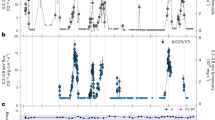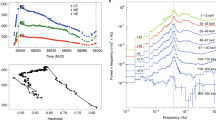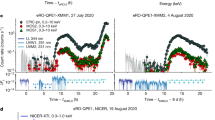Abstract
ONE of the striking features of a number of the transient X-ray sources is the ‘precursor peak’, an intensity maximum which precedes the rise to primary maximum and is separated from it by a dip. It is characteristic of A0620–00 (refs 1, 2), A1524–62 (ref. 3), A1118–61 (refs 4, 5), and A0535+26 (refs 6–9). The time scale across the precursor and subsequent dip is ∼ 4–20 d, though for A0620–00 the dip itself spans a time of only ∼ 10 h. Apart from flares, which have a much shorter time scale, there are similar secondary peaks observed during decay for some of the sources—A1524–62 and A0535 + 26, for instance. Any model of these transients must account for such features along with the concurrent softening of the X-ray spectrum in some cases, the temporal asymmetry of the light curve and, for sources A1118–61 (ref. 5) and A0535 + 26 (ref. 6), periodicities of 6.755±0.010 min and 104.14±0.16 s, respectively. It is possible to explain qualitatively the precursor and related phenomena on the basis of accretion-disk behaviour with a rising accretion rate M, followed by its gradual subsidence and the emptying of the disk. In this paper I present three schemes.
This is a preview of subscription content, access via your institution
Access options
Subscribe to this journal
Receive 51 print issues and online access
$199.00 per year
only $3.90 per issue
Buy this article
- Purchase on Springer Link
- Instant access to full article PDF
Prices may be subject to local taxes which are calculated during checkout
Similar content being viewed by others
References
Elvis, M., Page, C. G., Pounds, K. A., Ricketts, M. J., and Turner, M. J. L., Nature, 257, 656–657 (1975).
Ricketts, M. J., Pounds, K. A., and Turner, M. J. L., Nature, 257, 657–658 (1975).
Kaluzienski, L. J., et al., Astrophys. J. Lett., 201, L121–L124 (1975).
Eyles, C. J., Skinner, G. K., and Willmore, A. P., Nature, 254, 577–578 (1975).
Ives, J. C., Sanford, P. W., and Bell-Burnell, S. J., Nature, 254, 578–580 (1975).
Rosenberg, F. D., Eyles, C. J., Skinner, G. K., and Willmore, A. P., Nature, 256, 628–630 (1975).
Ricketts, M. J., Turner, M. J. L., Page, C. G., and Pounds, K. A., Nature, 256, 631–633 (1975).
Coe, M. J., Carpenter, G. F., Engel, A. R., and Quenby, J. J., Nature, 256, 630–631 (1975).
Kaluzienski, L. J., Holt, S. S., Boldt, E. A., and Serelemitsos, P. J., Nature, 256, 633–634 (1975).
Pringle, J. E., and Webbink, R. F., Mon. Not. R. astr. Soc., 172, 493–500 (1975).
Lightman, A. P., Astrophys. J., 194, 419–427 (1974).
Lightman, A. P., Astrophys. J., 194, 429–437 (1974).
Shakura, N. I., and Sunyaev, R. A., Astr. Astrophys., 24, 337–355 (1973).
Novikov, I. D., and Thorne, K. S., in Black Holes, Les Houches 1973 (edit. by De Witt, C., and De Witt, B. S.), 343–450 (Gordon and Breach, New York, 1973).
Page, D. N., and Thorne, K. S., Astrophys. J., 191, 499–506 (1974).
Lynden-Bell, D., and Pringle, J. E., Mon. Not. R. astr. Soc., 168, 603–637 (1974).
Lightman, A. P., and Eardley, D. M., Astrophys. J. Lett., 187, L1–L3 (1974).
Pringle, J. E., Rees, M. J., and Pacholczyk, A. G., Astr. Astrophys., 29, 179–184 (1973).
Thorne, K. S., and Price, R. P., Astrophys. J. Lett., 195, L101–L105 (1975).
Lightman, A. P., and Shapiro, S. L., Astrophys. J. Lett., 198, L73–L75 (1975).
Eardley, D. M., Lightman, A. P., and Shapiro, S. L., Astrophys. J. Lett., 199, L153–L155 (1975).
Shapiro, S. L., Lightman, A. P., and Eardley, D. M., Astrophys. J., 204, 187–199 (1976).
Avni, Y., Fabian, A. C., and Pringle, J. E., Mon. Not. R. astr. Soc. 175, 297–304
Shapiro, S. L., and Lightman, A. P., Astrophys. J., 204, 555–560 (1976).
Fabian, A. C., Maccagni, D., Rees, M. J., and Stoeger, W. R., Nature, 260, 683–685 (1976).
Bardeen, J. M., Press, W. H., and Teukolsky, S. A., Astrophys. J., 178, 347–369 (1972).
Author information
Authors and Affiliations
Rights and permissions
About this article
Cite this article
STOEGER, W., J., S. Accretion-disk scenarios of the precursor peak in X-ray transients. Nature 261, 211–213 (1976). https://doi.org/10.1038/261211a0
Received:
Accepted:
Issue Date:
DOI: https://doi.org/10.1038/261211a0
This article is cited by
-
Orbital topography and other astrophysical consequences of Rosen's bimetric theory of gravity
General Relativity and Gravitation (1978)
-
How do neutron stars evolve?
Naturwissenschaften (1977)
Comments
By submitting a comment you agree to abide by our Terms and Community Guidelines. If you find something abusive or that does not comply with our terms or guidelines please flag it as inappropriate.



